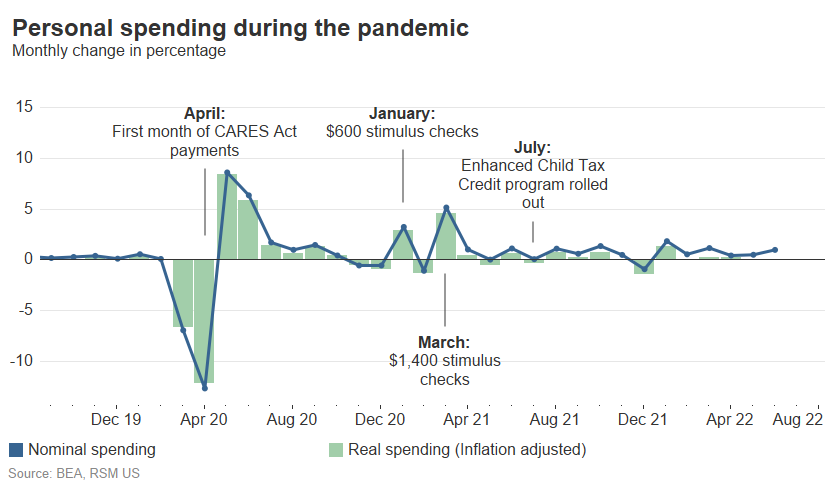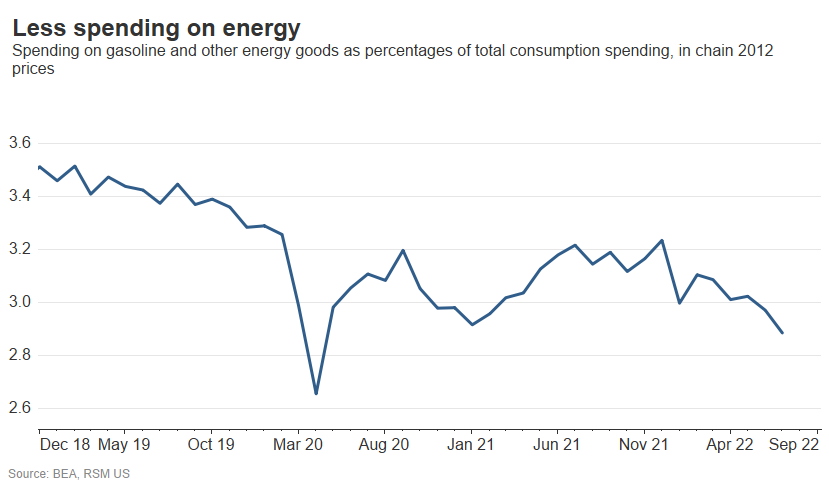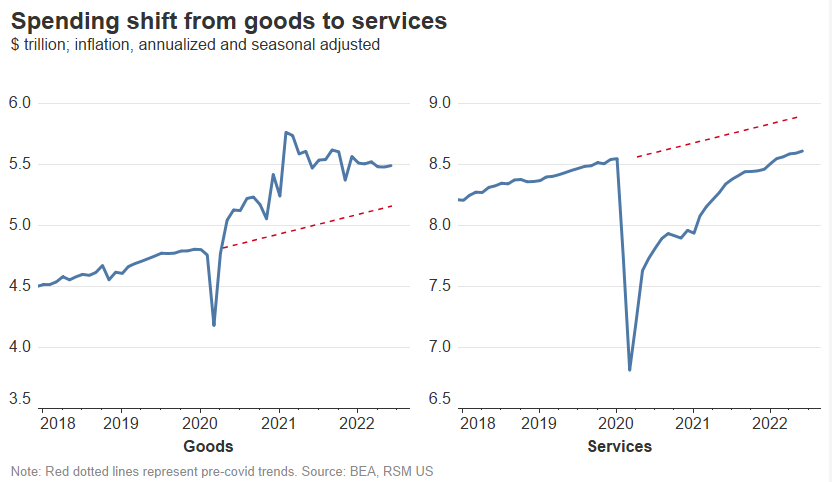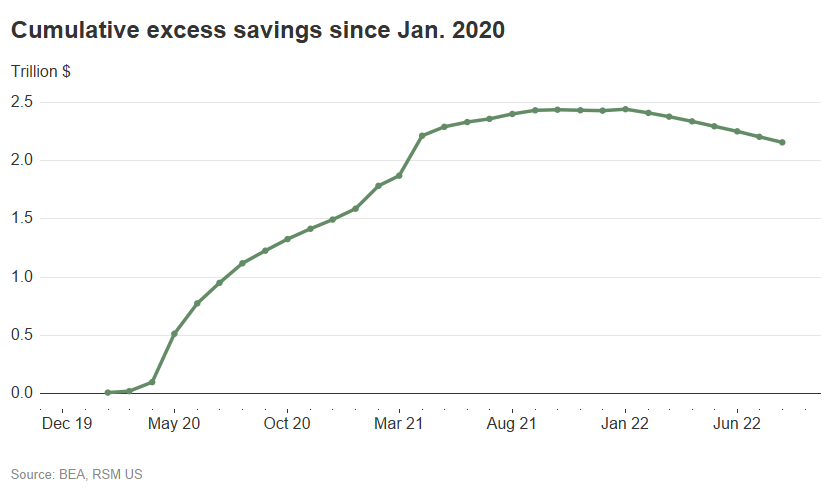Resources
Spending remains steady on strong income growth and inflation relief
REAL ECONOMY BLOG | August 26, 2022
Authored by RSM US LLP
U.S. personal income and spending in July signaled a gradual rebound of the economy in the third quarter after six months of declines in gross domestic product.
The catalyst was a combination of a tight labor market with steady wage income growth and a sharp drop in inflation on the back of falling energy prices.

With prices at the gas pumps dropping, consumers had more money to spend elsewhere. Total personal spending rose by 0.1% in dollar terms, and by 0.2% after inflation was factored in, the Bureau of Economic Analysis reported on Friday.
The Fed’s key inflation measure—the personal consumption expenditures price index—dropped by 0.1% on the month, not a surprise given data on the consumer price index released this month that showed overall prices declining for the first time since 2020.
We expect the headline inflation number to ease again in August as oil and gasoline prices continue to retreat. That should give spending another boost in the third quarter.
Personal income growth was robust in July, up by 0.2% from June in dollar terms, and by 0.3% after adjusting for inflation. Outsized labor demand was the primary explanation for such a bounce back in wage income. June’s income after adjusting for inflation fell by 0.3%.
Although the income data shows much-needed relief for American workers in a time of corrosive inflation that eats into most of their pay raises, the current level of wage growth might not be what the Fed is hoping for at the moment.

With a series of aggressive rate hikes, the Fed has somewhat contained the first-round effect of inflation. But that should not stop the central bank from continuing to increase rates as the second-round effect—a wage-price spiral—could form if elevated inflation lasts too long.
Inside the data
Spending for both goods and services increased by 0.2% each on the month. The higher spending on goods was driven largely by durable goods, rising by 1.5% on an inflation-adjusted basis. Gasoline spending as expected dropped by 2.7% in July, bringing down the total share of spending on gasoline and energy to 2.9% of the total monthly spending, from 3% in June.

At the same time, wages and compensation rose by 0.9% after adjusting for inflation, pushing disposable income up by 0.3% on the month, the highest growth rate since last July.
The savings rate stayed unchanged at 5.0%, significantly lower than the pre-pandemic average of around 7.2% as consumers reached into their excess savings to keep up with price gains. As a result, excess savings fell to $2.16 trillion in July from $2.2 trillion in June, and from the peak of $2.4 trillion in December 2021.

Regarding data on PCE inflation, goods prices deflated sharply, falling by 0.4%, while service prices also slowed down substantially, rising by only 0.1% compared to 0.7% in June.
Core inflation—which strips away food and energy prices—increased by only 0.08% in July. While most had predicted the headline inflation number to fall materially in July, the decline in core inflation has not been a sure bet. This data should reaffirm the notion that inflation might have peaked.
The takeaway
While the economy is slowing down, it is still on strong footing given strong job gains, business investments, corporate profits and excess savings.
That means the Fed can and should do more, starting with another 75-basis-point hike in September to a target of 4% by the end of the year.
Let's Talk!
Call us at (325) 677-6251 or fill out the form below and we'll contact you to discuss your specific situation.
This article was written by Tuan Nguyen and originally appeared on 2022-08-26.
2022 RSM US LLP. All rights reserved.
https://realeconomy.rsmus.com/spending-remains-steady-on-strong-income-growth-and-inflation-relief/
RSM US Alliance provides its members with access to resources of RSM US LLP. RSM US Alliance member firms are separate and independent businesses and legal entities that are responsible for their own acts and omissions, and each is separate and independent from RSM US LLP. RSM US LLP is the U.S. member firm of RSM International, a global network of independent audit, tax, and consulting firms. Members of RSM US Alliance have access to RSM International resources through RSM US LLP but are not member firms of RSM International. Visit rsmus.com/about us for more information regarding RSM US LLP and RSM International. The RSM logo is used under license by RSM US LLP. RSM US Alliance products and services are proprietary to RSM US LLP.

Condley and Company, LLP is a proud member of the RSM US Alliance, a premier affiliation of independent accounting and consulting firms in the United States. RSM US Alliance provides our firm with access to resources of RSM US LLP, the leading provider of audit, tax and consulting services focused on the middle market. RSM US LLP is a licensed CPA firm and the U.S. member of RSM International, a global network of independent audit, tax and consulting firms with more than 43,000 people in over 120 countries.
Our membership in RSM US Alliance has elevated our capabilities in the marketplace, helping to differentiate our firm from the competition while allowing us to maintain our independence and entrepreneurial culture. We have access to a valuable peer network of like-sized firms as well as a broad range of tools, expertise and technical resources.
For more information on how Condley and Company can assist you, please call (325) 677-6251.
